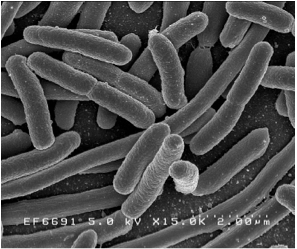Microbewiki:Naxibacter: Difference between revisions
(Naxibacter) |
m (Jenessa.philipczyk2 moved page MicrobeWiki:Jenessa.philipczyk2 to MicrobeWiki:Naxibacter) |
(No difference)
| |
Revision as of 03:27, 16 December 2013
Naxibacter

Classification
Higher order taxa
Bacteria; Proteobacteria; Betaproeobacteria; Burkholderiales; Oxalobacteraceae, Naxibaxter
Species
Naxibacter alkalitolerans; Naxibacter haematophilus; Naxibacter suwonensis; Naxibacter varians
Description and Significance
The substantial natural forests of the Yun- nan Province are sheltered from the presence of humans. New genera members were found in soil samples collected. One of the newly founded members of a new genus, Naxibacter was found in the extensive forest. The soil sample was also collected at an elevation of 3700 m in Lijiang. These samples were collected and tested for new useful antibiotics.
The genus Naxibacter originates from the country of China. The bacterium was isolated from the soil, clinical specimens, and water samples of Lijiang, Yunnan Province, China. "Naxi" refers to the Naxi ethnic group that live in Lijiang, Yunnan Province, China. A single strain was shown to produce polyketide antibiotics isolated from the samples. Polyketides are a large class of diverse compounds that are a class of secondary metabolites, organic compounds not directly involved in the normal growth, development, or redroduction and involve antibiotics, pigments, and regulatory conponents and the antibiotics are used medically or agriculturally. Another impactful feature of these species was the identification of phosphatidylinositol mannosides in its polar lipid profile. Phosphatidylmyolinositol Mannosides, or (PIMs), are glycolipids, which are found in the cell walls of Mycobactterium tuberculosis ; impacting the immune system of developed antibiotics for glycolipids and vanquishing a M. tuberculosis infection. Strains of the bacterium were isolated from the eye of a 90-year-old man in Tromso, Norway in 1996. Other strains isolated from water from Sweden in 1989 and also a 23-year-old man’s blood with multiple health problems in 1997. All strains were presumptively identified as Massilia-like bacteria.
Genome Structure
Within the genus Naxibacter , six strains were shown to have affiliation through experiment based on almost entire 16S rRNA gene sequences. It also shares the features of the genus and fatty acid profile. Based on the results of DNA–DNA hybridizations and phenotypic traits distinguishing other Naxibacter species.
Cell Structure and Metabolism
In general, Naxibacter cells are gram negative, rod shape, non-sporing with rounded ends. They can be non-motile or motile with one or more polar flagella. Cells are aerobic, catalase- and oxidase-positive, showing an oxidative metabolism with good growth occurring on nutrient agar, TSA, PYE agar, R2A agar and MacConkey agar. Cell colonies can range from beige, translucent, opaque with pale white–yellow and shiny colonies with entire, circular, convex, glistening with a diameter of approximately 2 mm.
Naxibacter alkalitolerans
Cells are gram-negative, oxidase-negative and catalase-positive with aerobic and chemo-organotrophic. Cells are non-spore forming rods with rounded ends, and motile with one or more polar flagella.
Naxibacter haematophilus
Described as blood loving. This name was given due to the isolation of the type strain from blood cells. The cells contain non-motile, non-spore-forming rods which are approximitely 2 mm long and 1 mm wide. Tests show that the cells are gram-negative and oxidase- positive, showing an oxidative metabolism.
Naxibacter suwonensis
Refers to Suwon region, Republic of Korea. This is the location of which the strain type was found within the samples. These cells are aerobic, gram-negative, and motile with a single flagellum, rod-shaped, also displaying catalase- and oxidase-positive.
Naxibacter varians
Cells show non-motile, non-spore-forming rods with gram-negative and oxidase positive, also distinguishinhg an oxidative metabolism.
References
- Xu P, Li WJ, Tang SK, Zhang YQ, Chen GZ, Chen HH, Xu LH , Jiang CL. 2005. Naxibacter alkalitolerans gen. nov., sp. nov., a novel member of the family ‘Oxalobacteraceae’ isolated from China. IJSEM 55(3): 1149-1153.:
- Kampfer P, Falsen E, Busse HJ. 2008. Naxibacter varians sp. nov. and Naxibacter haematophilus sp. nov., and emended description of the genus Naxibacter . IJSEM 58(7): 1680-1684.:
- Kampfer P, Mora R, Hermansson M, Persson F, Huber B, Falsen E, Busse HJ. 2007. Undibacterium pigrum gen. nov., sp. nov., isolated from drinking water . IJSEM 57(7): 1510-1515.:
- Weon HY, Yoo SH, Kim SJ, Kim YS, Anandham R, Kwon SW. 2010. Massilia jejuensis sp. nov. and Naxibacter suwonensis sp. nov., isolated from air samples . IJSEM 60(8): 1938-1943.:
- Kampfer P, Lodders N, Martin K, Falsen E. 2011. Revision of the genus Massilia La Scola et al. 2000, with an emended description of the genus and inclusion of all species of the genus Naxibacter as new combinations, and proposal of Massilia consociata sp. nov. IJSEM 61(7): 1528-1533.:
- Yi J, YanRu C, LiXing Z, ShuKun T, Yun W, WenJun L, Ping X, Kai L, PeiHong M, LiHua X. 2011. Large numbers of new bacterial taxa found by Yunnan Institute of Microbiology. Chinese Science Bulletin 56 (8): 709–712.:
